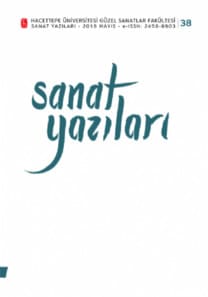İŞİTSEL PEYZAJ OLARAK GÜRÜLTÜ KAVRAMININ ÇAĞDAŞ SANATTAKİ ÜÇ TEMSİLİ
Sanayi devrimi ile birlikte insanların içinde yaşadıkları çevre dönüşüme uğramıştır. Ekonomik büyüme ve üretim ekseninde insanların yaşamlarını sürdürdükleri kentlerin peyzajları hem görsel hem de işitsel olarak bir önceki yüzyıldan farklı olarak değişmiştir. Buhar motorlarının, dökümhanelerin, fabrikaların ve otomobillerin çıkardıkları tüm sesler ile insanlar artık daha sesli bir ortamda yaşamaya başlamışlardır. Yaşam alanlarının değişen ses çevresi ile birlikte, insanın çevresini nasıl algıladığı da değişikliğe uğramıştır. Bu çalışma insanın çevresini sesler üzerinden nasıl algıladığını ve tanımladığını inceleyerek gürültü kavramını açıklayacaktır. İşitsel peyzaj olarak gürültü kavramı, çağdaş sanat içinden gürültü kavramını ele alan üç güncel örnek üzerinden incelenerek açıklanacaktır.
THREE REPRESENTATIONS OF THE CONCEPT OF NOISE AS SOUNDSCAPE IN CONTEMPORARY ART
With the advent of the Industrial Revolution the environment that the people lived underwent a transformation. Different from the previous century, the cityscapes changed both in visually and auditorily with the influence of economic growth and production. All the sounds the steam engines, iron foundries, factories and the cars made led the people live in noisier surroundings. With the changing sound atmosphere, the way how the people perceive their environment also changed. This study will explain the concept of noise through the analysis of how the people perceive and define their surroudings. The concept of noise as the soundscape will also be elucidated through three contemporary examples that deal with the noise.
___
Barham, Peter. (2004). Forgotten Lunatics of The Great War. Connecticut: Yale University Press.Büyük Türkçe Sözlük. (2015). Türk Dil Kurumu. Erişim: 12.11.2015. goo.gl/efxaCb
Cage, John. (1937). The Future of Music: Credo. Richard Kostelanetz (Ed.). John Cage: An Anthology, s. 132. New York: De Capo Press.
Cox, Christoph. (2009). Sound Art and the Sonic Unconscious. Organised Sound, 14, s. 19-26.
Danesi, Marcel. (2009). Dictionary of Media and Communications New York: M.E. Sharpe.
Evens, Aden. (2005). Sound Ideas: Music, Machines, and Experience. Minneapolis: University of Minnesota.
Futrell, Alison. (2006). The Roman Games: A Sourcebook. Blackwell: Oxford.
Graves, Robert. (2000). Goodbye to All That. Londra: Penguin Books.
Hendy, David. (2013). Gürültü: Sesin Beşeri Tarihi (Ç. Çidamlı, Çev.). İstanbul: Kolektif Kitap.
Kolukısa, Emrah. (Mayıs 2017). “Venedik ‘ÇIN’ladı...” Cumhuriyet. Erişim: 04.04.2018. goo. gl/HupXVA
Kopan, Yekta. (Mayıs 2017). “ÇIN: Tarihle yüzleş veya maskelemeye devam!”. Gazete Duvar. Erişim: 04.04.2018. goo.gl/chun3s
La Belle, Brandon. (2010). Acoustic Territories Sound Culture and Everyday Life. NewYork: Continuum.
Leibniz, Gottfried Wilhelm. (1989). Principles of Nature and Grace, Based on Reason. Roger Ariew, Daniel Garber (Ed.). Philosophical Essays, s. 206-213. Hackett Pub: Indianapolis.
Moles, Abraham A. (1966). Information Theory and Esthetic Perception. Urbana: University of Illinois.
Oxford. (2015). Oxford Dictionaries - Dictionary, Thesaurus, & Grammar. Erişim: 12.11.2015. goo.gl/8BCwiC
Remarque, Erich Maria. (1958). All Quiet on the Western Front. New York: Random House.
Schaeffer, R. Murray. (1977). The Soundscape. Vermont: Destiny Books.
Serres, Michel. (1995). Genesis (G. James ve J. Nielson, Çev.). Ann Arbor: University of Michigan Press.
Wollack, J. Edward. Tests of Big Bang: The CMB. Erişim: 4.5.2018. goo.gl/AYnQJM
Woolgar, M. Chris. (2006). The Senses in the Medieval England. Londra: Yale University Press.
- ISSN: 2458-8903
- Yayın Aralığı: Yılda 2 Sayı
- Başlangıç: 2001
- Yayıncı: -
Sayıdaki Diğer Makaleler
SPEKÜLATİF KURGU FİLM JENERİKLERİ VE X-MEN FİLMLERİ ÜZERİNDEN BİR İNCELEME
İŞİTSEL PEYZAJ OLARAK GÜRÜLTÜ KAVRAMININ ÇAĞDAŞ SANATTAKİ ÜÇ TEMSİLİ
AFİŞLE İLGİLİ LİSANSÜSTÜ TEZLERİN BAZI TANIMLAYICI ÖZELLİKLERİNİN İNCELENMESİ
GOULD’UN KONTRAPUNTAL YAKLAŞIMI: TEKNOLOJİ, MÜZİK, MİLLİYETÇİLİK
BİHZÂD’IN MİNYATÜRLERİ: MİNYATÜR SANATINDA ZAMAN VE MEKÂNIN İNŞASINA DAİR İKİ ÖRNEK
20. YÜZYILDAN GÜNÜMÜZE PLASTİK SANAT ESERİNDE ESTETİK BİR DEĞER OLARAK YAZININ VARLIĞI
JEAN BAUDRİLLARD’IN SİMÜLASYON KURAMI VE TANSEL TÜRKDOĞAN’IN SANAT UYGULAMALARI
KÜLTÜREL MİRASIN KORUNMASINDA FOTOGRAMETRİ TEKNİĞİNİN KULLANILMASI: ANA TANRIÇA HEYKELİ ÖRNEĞİ
